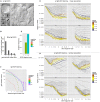Pre-clustering of the B cell antigen receptor demonstrated by mathematically extended electron microscopy
- PMID: 24367367
- PMCID: PMC3854567
- DOI: 10.3389/fimmu.2013.00427
Pre-clustering of the B cell antigen receptor demonstrated by mathematically extended electron microscopy
Abstract
The B cell antigen receptor (BCR) plays a crucial role in adaptive immunity, since antigen-induced signaling by the BCR leads to the activation of the B cell and production of antibodies during an immune response. However, the spatial nano-scale organization of the BCR on the cell surface prior to antigen encounter is still controversial. Here, we fixed murine B cells, stained the BCRs on the cell surface with immuno-gold and visualized the distribution of the gold particles by transmission electron microscopy. Approximately 30% of the gold particles were clustered. However the low staining efficiency of 15% precluded a quantitative conclusion concerning the oligomerization state of the BCRs. To overcome this limitation, we used Monte-Carlo simulations to include or to exclude possible distributions of the BCRs. Our combined experimental-modeling approach assuming the lowest number of different BCR sizes to explain the observed gold distribution suggests that 40% of the surface IgD-BCR was present in dimers and 60% formed large laminar clusters of about 18 receptors. In contrast, a transmembrane mutant of the mIgD molecule only formed IgD-BCR dimers. Our approach complements high resolution fluorescence imaging and clearly demonstrates the existence of pre-formed BCR clusters on resting B cells, questioning the classical cross-linking model of BCR activation.
Keywords: BCR; Monte Carlo simulation; electron microscopy; immuno-gold-labeling; maximum-likelihood method; oligomerization.
Figures





Similar articles
-
The nanoscale spatial organization of B-cell receptors on immunoglobulin M- and G-expressing human B-cells.Mol Biol Cell. 2017 Feb 15;28(4):511-523. doi: 10.1091/mbc.E16-06-0452. Epub 2016 Dec 14. Mol Biol Cell. 2017. PMID: 27974642 Free PMC article.
-
Monte Carlo study of B-cell receptor clustering mediated by antigen crosslinking and directed transport.Cell Mol Immunol. 2011 May;8(3):255-64. doi: 10.1038/cmi.2011.3. Epub 2011 Feb 28. Cell Mol Immunol. 2011. PMID: 21358668 Free PMC article.
-
Antigen footprint governs activation of the B cell receptor.Nat Commun. 2023 Feb 22;14(1):976. doi: 10.1038/s41467-023-36672-0. Nat Commun. 2023. PMID: 36813795 Free PMC article.
-
B-cell receptor: from resting state to activate.Immunology. 2012 May;136(1):21-7. doi: 10.1111/j.1365-2567.2012.03564.x. Immunology. 2012. PMID: 22269039 Free PMC article. Review.
-
Structural and immunogenomic insights into B-cell receptor activation.J Genet Genomics. 2020 Jan 20;47(1):27-35. doi: 10.1016/j.jgg.2019.12.003. Epub 2020 Jan 9. J Genet Genomics. 2020. PMID: 32111437 Review.
Cited by
-
Integrin CD11b Negatively Regulates B Cell Receptor Signaling to Shape Humoral Response during Immunization and Autoimmunity.J Immunol. 2021 Oct 1;207(7):1785-1797. doi: 10.4049/jimmunol.2100070. Epub 2021 Sep 1. J Immunol. 2021. PMID: 34470858 Free PMC article.
-
Immune system modeling and analysis.Front Immunol. 2014 Dec 19;5:644. doi: 10.3389/fimmu.2014.00644. eCollection 2014. Front Immunol. 2014. PMID: 25566257 Free PMC article. No abstract available.
-
Isotype Specific Assembly of B Cell Antigen Receptors and Synergism With Chemokine Receptor CXCR4.Front Immunol. 2018 Dec 18;9:2988. doi: 10.3389/fimmu.2018.02988. eCollection 2018. Front Immunol. 2018. PMID: 30619343 Free PMC article. Review.
-
Immuno-receptors: from recognition to signaling and function.Eur Biophys J. 2018 May;47(4):363-371. doi: 10.1007/s00249-018-1294-2. Epub 2018 Mar 29. Eur Biophys J. 2018. PMID: 29600443 Review.
-
Computational Model Reveals a Stochastic Mechanism behind Germinal Center Clonal Bursts.Cells. 2020 Jun 10;9(6):1448. doi: 10.3390/cells9061448. Cells. 2020. PMID: 32532145 Free PMC article.
References
LinkOut - more resources
Full Text Sources
Other Literature Sources

